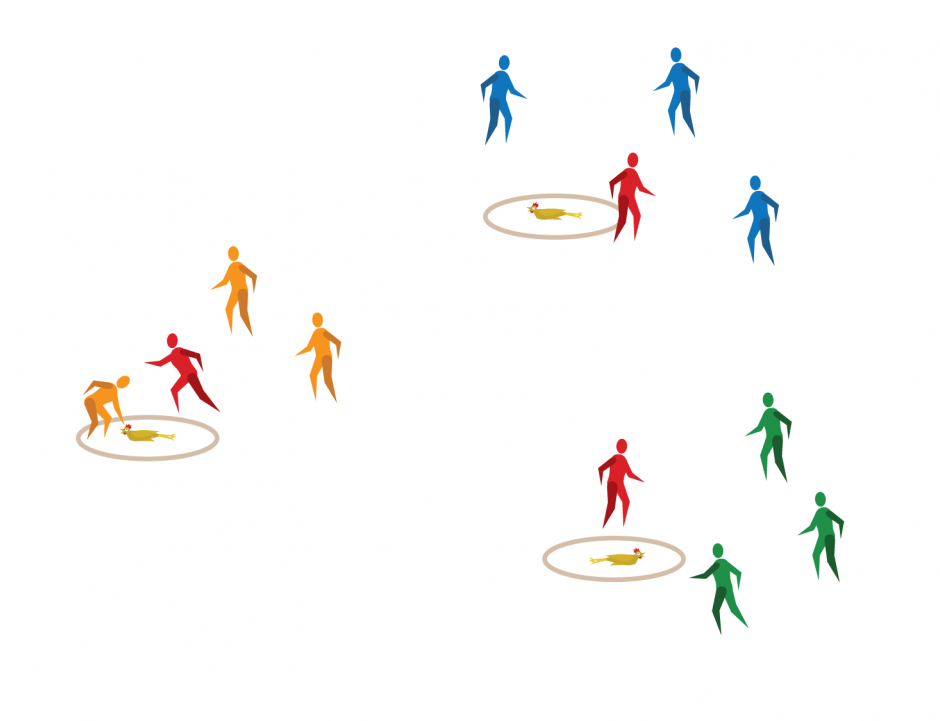TGfU Category: Zone Games
Locations: gymnasium, outdoor space (e.g., field, tarmac)
Game/Sport Connections
Zone games are activities that involve controlling an object, keeping it away from opponents, and moving it into position to score. Both offensive and defensive players share the same playing area as they work to prevent the other team from scoring. By playing these games, participants develop skills and tactics to play other zone games or games that require the application of similar skills, concepts, and strategies (e.g., soccer, handball, ultimate Frisbee, football, basketball, hockey, goalball, wheelchair basketball, lacrosse).
Activity Overview
Participants learn about and practise applying offensive and defensive skills in a game.
Key Movement Skills, Concepts, and Strategies
Throughout the activity, consider highlighting the following skills, concepts, and strategies for effectively applying offensive and defensive skills. Note that this list is not exhaustive and further learning opportunities may arise during the task.
Movement Skills and Concepts
- Locomotion and relationship: travelling safely within the activity area while trying to avoid being tagged by the “protector.”
- Spatial awareness: knowing where and how to move while attempting to touch the object and avoid being tagged by the protector; as the protector, knowing where to be positioned in an optimal location to tag participants).
Movement Strategies
Decision making: learning how to make decisions about what to do (e.g., deciding to try and touch the object when the protector is focused on another participant).
Considerations
- Incorporate some or all of the variations listed in the “Variations” section while planning the activity. This will help to best meet the diverse backgrounds, identities, needs, and interests of participants and maximize the fun, inclusion, participation, and success of everyone.
- To elevate participant voice and choice, periodically pause the activity and share the variations with participants. Ask them to determine how they would like to change the activity to maximize the fun, inclusion, meaningful participation, and success for everyone. Encourage participants to add any variations of their own.
Equipment
- 1 hula hoop per group
- 3 objects per group (e.g., rubber chickens, beanbags, various sizes, shapes, and textures of balls)
- Pool noodles for tagging (optional)
Safety
- Inspect the equipment and activity area to identify and remove hazards. Check that the activity surface provides sufficient traction.
- Establish the boundaries for the designated playing area at a safe distance from walls and obstacles. Share the boundaries with participants.
- Review the safety rules and activity instructions with participants prior to the activity.
- Instruct participants to be aware of their surroundings, including the locations of other participants during play.
How to Play
- Divide participants into small groups (e.g., triads, groups of 4 – 6).
- Provide each group with a hula hoop. Groups place their hoop on the ground in the designated playing area away from any walls, obstacles, or other groups.
- Groups select 3 objects (e.g., rubber chickens, beanbags, various sizes, shapes, and textures of balls) that represent something that must be protected (e.g., water sources, culture, language, animals, children) and place them in their hoop. Groups may change their selected objects at predetermined intervals throughout play.
- Ask 1 participant in each group to volunteer to be designated as the “protector.” The protector stays outside of the hoop and may not go through the hoop or touch the protected objects.
- Other group members position themselves around the hoop and try to touch the protected objects while the protector tries to tag them. Groups may choose to use an implement (e.g., pool noodle) to tag other participants when acting as the protector or to extend their reach to touch an object. Remind participants that a tag is a touch on the back, shoulders, or arms—not a push, punch, or grab.
- If a participant touches an object, they move to another group and try to touch that group’s objects.
- If a participant is tagged by the protector, they move to another group to try and touch their objects.
- Alternate roles frequently so all participants have the opportunity to be the protector.
- After a period of play, provide participants with some or all of the variations. Ask them to decide how they might change the game to enhance the fun, inclusion, and participation for everyone. Encourage participants to add any variations of their own.
- Consider having groups share their variations and select another variation to try with their group.
Image: Visual Depiction of the Activity Instructions

Pause for Learning
Throughout the activity, ask open-ended questions to help participants refine their movement skills, strategies, and tactical solutions. Examples include:
- What strategies do you apply to be successful if you are attempting to touch/remove the objects?
- How do you move to avoid being tagged by the protector?
- If you are a protector, what is a successful way to position yourself so that you can guard your objects?
- Which games or sports have you played or know about that use similar rules and strategies to the ones used in this game?
Variations
- Have a safe space where participants cannot be tagged.
- Use larger objects in the centre of the hoop for ease of manipulation.
- Use skipping ropes or floor markers to contain the objects rather than a hoop.
- Add more objects and have 2 or more protectors at each hoop.
- Use a smaller hoop.
- Participants attempt to remove objects from the hoop instead of just touching them.
- Group members travel to other groups attempting to take an object without being tagged. If successful, they bring the object back to their hoop. If tagged, they surrender the object.


